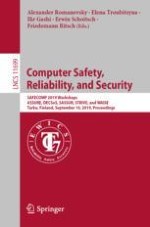This book constitutes the proceedings of the Workshops held in conjunction with SAFECOMP 2019, 38th International Conference on Computer Safety, Reliability and Security, in September 2019 in Turku, Finland.
The 32 regular papers included in this volume were carefully reviewed and selected from 43 submissions; the book also contains two invited papers. The workshops included in this volume are:
ASSURE 2019:
7th International Workshop on Assurance Cases for Software-Intensive Systems
DECSoS 2019:
14th ERCIM/EWICS/ARTEMIS Workshop on Dependable Smart Embedded and Cyber-Physical Systems and Systems-of-Systems
SASSUR 2019:
8th International Workshop on Next Generation of System Assurance Approaches for Safety-Critical Systems
STRIVE 2019:
Second International Workshop on Safety, securiTy, and pRivacy In automotiVe systEms
WAISE 2019:
Second International Workshop on Artificial Intelligence Safety Engineering
